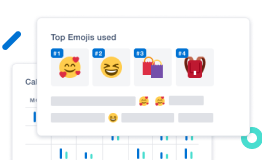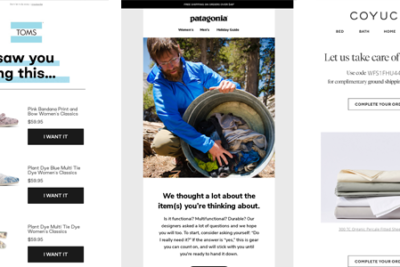For every $1 spent, email marketing has an ROI of $38. It’s the most powerful revenue-generating marketing tool out there, but its effectiveness is no secret.
In 2018, more than 290 billion emails were sent every day. How do you stand out among all of that noise? How do you make sure your email campaigns don’t just make that $38 for every dollar you spend but perform above average?
By applying the following advanced email marketing strategies.
1. Offer Relevant Signup Incentives
People don’t just give their email to anyone. You need to give them a reason to sign up. Luckily, people also like free stuff.
Entrepreneur Ramith Sethi gives a ton of material away for free and he makes sure it’s better than what his competition charges for. With an email list of over 400,000 subscribers, this tactic seems to work well for him.
Think about the kind of lead magnets you could create that
- would specifically appeal to your target audience.
- are related to the content on the pages they’d sign up from.
- are relevant to what you’re selling.
2. Segment, segment, segment
As soon as someone signs up to your list, you learn a few things about them. Even if you don’t use checkboxes or other means to ask about their preferences, you know which page they signed up on, which lead magnet they were interested in, and what time of day they joined your list.
Based on that, you can divide your subscribers into different groups or segments so you can create better-targeted campaigns and avoid annoying people with offers that aren’t interesting to them.
Just some examples of data you can use to segment your list are:
- demographics.
- purchase history.
- average purchase amount.
- browsing behavior/interests.
- where they are in the customer lifecycle.
- which lead magnet they signed up for.
- email frequency preferences.
- open rate and (in)activity.
The more information you can gather from your customers, the more options you have to segment your list. Things like purchase history and browsing behavior you can track internally, but other information you will have to ask for when people signup, place an order, or surveying them via email.
3. Minimize Unsubscribes by Surveying Your Users
Irrelevant emails are the #1 reason why people unsubscribe and 91% of unhappy customers won’t buy from you again. This is where survey emails come in. They allow you to better understand your subscribers, collect useful information to personalize lifecycle campaigns, and gather product reviews and feedback.
Check out our list of survey invitation strategies and our article on how to ask questions to keep customers engaged for tips on how to best survey your users.
4. Personalize Your Emails
We already mentioned the importance of segmentation and surveying your subscribers so you have no excuse to simply slap a [FIRST NAME] into your email templates and call it a day. There are so many more ways you can personalize your emails depending on the data you have on your customers.
Just a few ideas:
- You can personalize your email subject lines. This can increase open rates by 16%.
- You can personalize product recommendations based on a customer’s previous purchases.
- You can announce in-store promotions based on where someone lives.
In fact, a study has shown that personalization based on a user’s interests and demographic characteristics often has more success than forcing the idea of a personal connection by using someone’s name.
Adapting the content of your email campaigns to the individual profile of users is one way to increase conversion through personalization. Another is customizing the sending time based on when they’re most likely to check their inbox.
5. Personalize Your Send Time
Various email service providers have done studies around the best time to send your emails and the results rarely match. While we’d all love a specific best day and time to schedule our campaigns, there’s no such thing.
When someone checks their emails and is most likely to engage with them, depends on a large number of factors such as their daily routine, the kind of work they do, and even their age.
If your customers are in different time zones, you’ll need to take that into account as well. Even a few hours difference (based on different time zones) can have a significant impact on your campaign’s performance.
While there is no “best time to send for everyone,” you can still customize your send times by creating relevant segments based on (a combination of) the following criteria:
- the subscriber’s timezone.
- the subscriber’s age.
- the subscriber’s profession or industry.
- when they usually engage with your emails.
With the right tools, you can even optimize our sending time for each individual subscriber.
6. Create Exclusive Content
Aside from giving customers a reason to sign up, you also need to give them a reason to stay. If you’re sending out the same kind of content and offers that are freely accessible on your website, your emails aren’t providing any added value and users might be inclined to unsubscribe.
Share tips on how to use your products with existing customers, offer exclusive discounts to subscribers or share new product launches with your list first. There are various ways to reward people for sticking around and increasing their loyalty at the same time.
7. Re-send Emails to Non-openers
Here’s a dirty marketing secret: you can get users to open the email they previously ignored by sending it to them again… with just a few little tweaks.
For some reason, these non-openers didn’t find your original subject line enticing enough to click on, so you’ll need to come up with a better one. There’s no need to change the copy, images, or call-to-action as they haven’t seen these yet.
Do wait a day or two before you do this so you give the subscribers who would click the chance to do so. Then, create a new segment including only the non-openers, copy the original email, change the subject line, and hit send. In fact, use an email address checker to verify emails to be sure you’re sending emails to verified addresses.
8. Offer Single-Campaign Opt-outs
If you decide to target your list aggressively with drip campaigns, consider including a simple and easy way for subscribers to opt-out of individual drips.
Imagine you create a 7-part welcome drip. At the beginning of the email, you can have a small call to action saying:
“You’re receiving this email because you signed up for <company or promo or product>. This is email 1 out of 7. If you’d like to stop receiving this series, please click here. You can unsubscribe from all future emails by using the unsubscribe link in the footer.”
This looks ugly, no question about it, but it also allows you to send emails aggressively while lowering your risk of being marked as spam.
9. Have Transparent Subject Lines
While mysterious subject lines can be curiosity-inducing, they don’t assure the recipient that they’re worth clicking. If you’re using more catchy than clear subject lines right now, try testing them against subject lines that clearly state what the subscriber can expect.
This is especially important for transactional emails but it applies just as well to more informational drip campaigns.
Have a look at this subject line from coffee brand Keurig:

You know exactly what you’ll find in this email: a deal on Keurig coffee pods.
Not used to writing subject lines like this? We’ve gathered some inspiration for you here.
10. Apply 10-10-80 Testing
A popular and effective A/B testing trick is to send two email variations each reaching 10% of your subscriber base. Based on the results after X amount of time (usually a full day but sometimes as little as 4 hours—waiting longer helps you capture more data), the winning variation automatically gets sent to the remaining 80% of the subscriber base.
You can set up a test like this for each of your campaigns. After a while, you’ll get great insights into which type of copy, images, and offers work for your target customers.
11. Experiment with animated GIFs
See the full animated GIF email here.
It’s hard to spend a day online without coming across a GIF these days. When used correctly, they can liven up your emails and draw the reader’s attention. We’ve put together a list of resources for you to start experimenting with animated GIFs in your email campaigns to increase engagement.
If you haven’t used GIFs in your emails yet, read here why you should consider them and how to add them the right way.
If you’re looking to up your GIF game, check out these tips and tricks.
And if you’re looking for inspiration, we’ve curated a list of great email examples with GIFs for you.
12. Create Birthday Email Marketing Campaigns
Birthday emails offer the perfect opportunity for brands to connect with subscribers on a personal level. Data from Experian show that birthday emails drive 342% higher revenue compared to traditional promotional emails.
342%!
You can create successful birthday campaigns by following the personalization tips in this article and checking out these specific birthday email marketing strategies.
13. Give New Products The Attention They Deserve
Are you spending just as much time marketing your new products as you are ideating and producing them? If not, it’s time to make some changes.
Your one-off email communicating a product launch might get some subscribers interested but if you’ve heard of the famous marketing Rule of 7, you know people need to be exposed to something multiple times before they’ll take action on it.
There are various email marketing tactics you can use to introduce a new product via email. Test what works best for your audience and try to tweak your strategy with every launch.
14. Optimize Your Post-Purchase Emails to Drive Product Reviews
As 88% of consumers trust online reviews as much as personal recommendations, getting those reviews is crucial. Don’t expect your customers to leave a glowing review on their own. Be proactive and reach out to them directly when they made a purchase and you’re still top of mind.
How you go about that? We put together 6 strategies for you here and gathered some best practices for collecting reviews via email here.
15. Set up Cart Abandonment Sequences
It only takes a little nudge to sway people who’ve filled up their cart but didn’t check out. 33% of opened cart abandonment emails drive a sale. That means you lose out on a big chunk of revenue if you don’t have a cart abandonment sequence set up.
There are several messaging tactics you can use in your cart abandonment emails and with MailChart’s data, you can analyze your competitors’ sequence to build a sequence that converts right from the start.
16. Improve Your Email Deliverability
None of the strategies above matter if your emails don’t reach your subscriber’s inbox. Don’t make the mistake of excitedly starting to create a whole slew of email marketing campaigns without making sure you’ve done everything you can to optimize your deliverability and avoid the most common mistakes.
Want to know which kind of email marketing strategies your competitors are using? Sign up for a free MailCharts account and find out without having to sign up to their lists.






